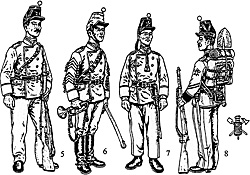 Large version of illustration: (slow download: 91K)
Large version of illustration: (slow download: 91K)
Figure 5: Infantryman, Full Dress/Service Dress, c.1910 [after a contemporary print & photos] Black leather shako with brass unit number on the front, red pompon. Entirely dark blue tunic edged with red piping on the collar, cuffs, front opening, shoulder straps and hip pocket flaps [the latter seems to have been sometimes piped, sometimes not, to judge from contemporary depiction's] , brass buttons. Dark blue trousers with red seam piping. Black boots and belting . A white scarf seems to have been normally worn around the throat, under the tunic collar, in the French manner. Mexican Model 1895 Mauser rifle with black strap. This is the Model 1898 uniform, which was an only slightly modified variation of a uniform first adopted in 1869. Photos of the period commonly show the enlisted men's uniform as poorly cut, of inferior materials and badly fitting.
Figure 6: Cavalry Trumpeter, Marching Order, c.1910 [based on a J. Hefter sketch ] Shako in white cotton cover , red pompon [the shako device would be the unit number in white metal]. Dark blue tunic edged with red piping, identical to the infantry model but with white metal buttons. Two sets of "Golpes" on the sleeve: gold lace chevrons backed with red cloth which shows as an edging all around, gold hanging pompons at front and rear only [the Hefter sketch doesn't show the central row of pompons normally depicted; possibly this is an early form of this distinction?] . Dark blue trousers with red side stripe, black boots and belting, white neck scarf. Brass trumpet with red cords.
Figure 7: Mountain Artillery, Full Dress, c.1900 [after photo] Black leather shako with brass front badge of crossed cannon with small flaming grenade above, crimson pompon; crimson retaining cords attached to the rear of the shako, circling the neck and hanging in tassels on the breast [cavalry would wear these same cords in red for full dress] . Entirely dark blue tunic with crimson piping edging collar, cuffs, shoulder straps and front opening, brass buttons. Dark blue trousers with a crimson "lampasse" down the outer seams [i.e. 2 wide stripes with a coloured piping between, with a dark blue 'light" showing between the stripes and the piping].
Black boots and belting. White neck scarf, a pair of white gloves are tucked into the top front opening of the tunic [the men in the photo are depicted manning a gun, presumably the gloves have been removed to keep them from getting dirty] . The only armament depicted in the photo are long sword bayonets with blades of a slightly "yataghan" form, but two men shown in 3/4 rear view have rather small black pouches [with the same device worn on the shako on the pouch flap] worn at the rear of the waistbelt, suggesting carbines of short rifles may have been carried for service.
Figure 8: Engineer Sapper Corporal, Full Dress, c.1898 [after J. Hefter] Black leather shako with brass front badge and red pompon. Dark blue tunic with black collar and cuffs, dark blue shoulder straps, all edged with red piping, brass buttons; Hefter also shows a red piping edging the bottom of the skirts. 6 buttons are placed in two vertical rows of 3 on either side of the rear of the skirts imitating pocket flaps. Diagonal yellow rank stripe edged red on the lower sleeve; yellow [cloth or metal?] branch badge on the upper sleeve. Dark blue trousers with red "lampasse". Black belts and pouch, the latter with a brass branch of service badge on the flap.
Pack of a brown cowhide with a darkish blue horseshoe roll strapped around it [greatcoat?] , a light grey roll strapped to the top [blanket?] and a white metal waterbottle strapped to the rear face. This was the regulation uniform of the 1898 regulations for all engineering troops, which continued in use, with only minor modifications, until 1913-14 [at least for other ranks] . The rank stripes depicted were those specified by the 1898 regulations; it is unclear to what extent, if any, these were still in use by the outbreak of the revolution [see next figure] . The detail sketch to the lower right is the basic branch or arm of service badge for engineering troops [consisting of an upright gabion with a flaming torch through the centre, superimposed on crossed spade and axe]; this was worn on the upper sleeves, shako front and pouch flap.
Some engineering specialities wore this badge slightly modified to indicate their particular function; i.e. telegraph troops had lightning bolts emanating from the top of the torch and a pair of wings on either side of the gabion, railroad engineers replaced the central gabion and torch with the profile of a locomotive, etc. This figure is armed with the "Mexican model" Remington rolling block rifle regulation at this time; by 1911 this would have been largely replaced by the Mauser, though there is some indication it might have still been in use in some small rural garrisons [and, of course, it was widely used by early insurgent forces].
The Federalist Army 1911-1913
The Constitutional Army 1913-1917
-
Figures 13-16: Gen., Pancho Villa, Capt., Major
Figures 17-20: Officers
Figures 21-23: Infantry
Figures 24-26: Infantry
Back to Table of Contents: Booklet No. 5, Mexican Army 1900-20
Back to El Dorado List of Issues
Back to Master Magazine List
© Copyright 1997 by The South and Central Military Historians Society
This article appears in MagWeb (Magazine Web) on the Internet World Wide Web.
Other military history articles and gaming articles are available at http://www.magweb.com